|
|
||
|
|
Select Aquatics of Erie, CO |
|
|
|
||
|
|
Keeping The Xiphophorus montezumae |
|
|
|
||
|
|
|
|
|
|
|
|
|
|
|
|
|
Basic Stats:
Size tank- 10 gallons or
larger |
|
|
|
|
|
|
|
Community Fish- Yes |
|
|
|
|
|
|
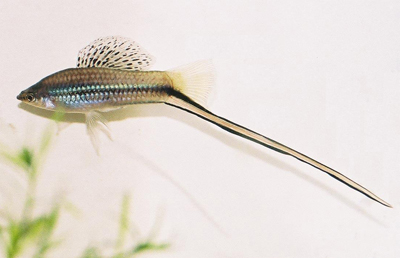
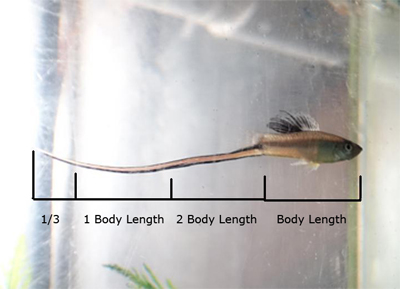
times their body length. Aware of this badge of distinction,
they are constantly showing off to one another, and a ranking
order does establish itself. However, the males never seem
to damage one another's fins, though they will chase one
another around.
swords, and many monties seem to continue to grow
their sword throughout their lifetimes, so that a fish
with a very long sword is often a very old fish.
This fish is nearly 6 inches long, but its body is less
than 2 inches long.
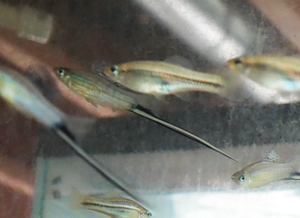
Similar to the way in which the Poecilia velifera is
not a pet shop molly,
the Xiphophorus montezumae is not just another
swordtail. There is a reason
why the X. mayae or X. helleri have been nearly always
available, but the
"montys" have only been available about a third of the
time. Smaller brood
sizes, the need for long term consistent water quality
and clean conditions,
combined with a healthy diet may account for why they
are not more
frequently seen.
By far these Tamosopos are the most dramatic swordtail,
with tuxedo black
markings and extremely long sword, a sword that is
routinely 1.5 times its
body length.
Also see the basic Care guide for this fish
HERE.
was told this line produced males with
red stripes, which is one color rarely
seen on a monty. It is true, and the
orange/red markings can be seen on this
male. However, I have not yet attempted
to select breeders for the red color.
The montezumae is not the biggest swordtail. Stories
of 9 inch montezumaes in the wild exist, but in the aquarium,
efforts by many
to increase their size - from nose tip to sword tip - has not produced
individuals larger than 5.5 inches.
The X. helleri Rio Otapa will produce males that have reached 6.25
inches here, and the X. mayae has produced
occasional males that have reached 6 inches. See
How big will these fish
get, for info on efforts to reproduce the larger
fish claimed to be seen in the wild.
When kept in conditions discussed in this essay, they
are generally a hardy fish, tolerating temps up to roughly
80 degrees, and doing best at
74-78 degrees. However, the areas where this fish needs special attention
are often
overlooked. The result is they
are rarely seen or offered.
Though over 300 have been shipped since Select Aquatics
began, they can still be
difficult to find, and stories of unhealthy fish or early maturing males
being sent out to customers
are complaints that have been
received. The result is that this robust line has not been readily
available, and many
tanks have been set up here to
get these back out into the hobby.
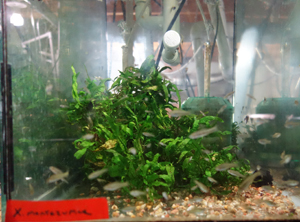
Trios can be bred in 10 gallon tanks, and for
breeding it is best to put a single
male with 2 or 3 females. With a colony of multiple
mixed sex fish, a tank of at
least 29 gallons should be used. Though the larger
males will assert dominance
and establish an order of heirarchy, they never seem to
cause any damage to one
- another, though there can be some
chasing.
Unlike other swords, they are not fry eaters, and
most fry do well when born into
a tank of adults, but they should be caught and
separated to a 10 gallon tank to
grow out and have better access to food. Experience
here has shown that batches
of fry do not do well when kept and raised in net
breeders. For some reason, up to
half of batches can be lost when confined to a net
breeder. Sometimes a "whirling"
condition will overcome their swimming when in a
closely confined net or plastic
breeder, and they will then start dying shortly
thereafter. It appears to be a disease,
and I have seen it in two lines I have received over
the past 10 years. This line here
has been here since 2010. We no longer use net
breeders, and that condition has
not been seen here for at least 4 years.
They will drop 10-30 young after a gestation of roughly
30 days, depending on
temperature. As they mature, they do produce occasional
early maturing males,
and these should be culled to maintain the size and
robust health of the line.
Similar to other swords, secondary sexual
characteristics begin to present
themselves at 4-5 months, and first groups of fry are
produced 7-10 months.
Later maturing males should be used as breeders, as
they will be your larger
individuals, and they may take 7-9 months before being
ready to breed. It is
thought that some of the rumors of their taking up to
18 months- 2 years to sex
out may be connected to the length of their swords, as
they seem to continue to
grow throughout their lives. Older males dragging
around swords over twice their
body length are not uncommon. But like all swordtails,
breeding will begin as
soon as the gonopodium is present, and sword length does
not matter.
throughout the site, the young
are raised in 30 gallon grow out
tanks with a diet heavy in BBS,
red, black and white worms, and
a flake diet rich in both a
vegetable component and quality
protein ingredients.
Though they are very good about not
eating their fry, all fry should
be removed and placed into a smaller
tank to be raised separately. However,
young do best when they are not
confined to a net breeder, but allowed
to grow out in a moderately planted tank
with minimal substrate, healthy aeration,
and effective filtration.
|
|
|
An Issue with raising Their Fry Many of us will
put a gravid female into a net breeder to drop her fry, so that
few are lost. The montezumaes are very good |
|
|
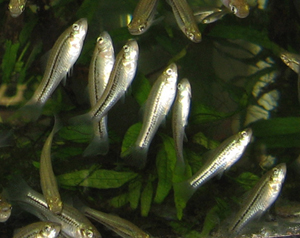
A 40 or 55 gallon tank are ideal for them, and
a group of fully sworded males
with their tall speckled dorsals makes any effort to
provide what they need worth
the effort. Generally they are easy to keep and can be
fairly prolific. New fry
should be routinely raised up separate from the adults,
and when kept in a community
tank, thought should be given to the possibility of
their being nipped by other fish.
The monties are not aggressive to other fish
This is a group of 5 month old generally unsexed fish.
Females can often be
identified by a darkening gravid spot at about this
age. They are a sleek, shiny,
golden fish that is unlike any other swordtail, and
young can be identified as
montezumaes easily.
The issues with the montezumaes comes down to
water quality and feeding. In a tank with a bottom of accumulating
mulm, the fish may produce at a rate that will keep the line going, but losses
before reaching adulthood will occur.
The monties require moderate aeration, good filtration and a
varied diet of dry foods, baby brine shrimp for new fry,
and various frozen and
live foods to ensure better health, such as frozen adult brine
shrimp, bloodworms, etc.
Live
feedings of blackworms, chopped redworms or white worms are taken eagerly.
The Montezumae tanks are
set up here in the manner described throughout this site, for more info,
see "A
cleaner Approach to Fishkeeping". All tanks are bare bottom with a single layer of 1/4" pea
gravel over 1/3 - 1/2 of
the tank
bottom. A filter that removes debris from the aquarium (Not sponge or undergravel
filters) is used and weekly
water
changes of 50%+ are done. Two changes of 25% per week is even better
for the stability of the tanks,
and the overall health of
the fish. However, 50% per week will keep
them in good shape.
In 20 years of keeping this fish they have
been particularly disease resistant. I have never had a case of
ich or fin rot with this
fish. However, they do seem to be prone to "livebearer disease" when the
parasitic
organism is present. They
can be cured with the use of Levamisole. This condition is evidenced by a
thinning
down and eventual wasting
away of the fish. Within a couple weeks it then results in the loss of
the fish.
The
Xiphophorus
montezumae is easily the most elegant and regal swordtail that one can
keep, and this
population is the largest
and most colorful, with the longest sword of any swordtail. Please
consider keeping
this fish, as it would be
a tremendous shame to lose this fish from the hobby!